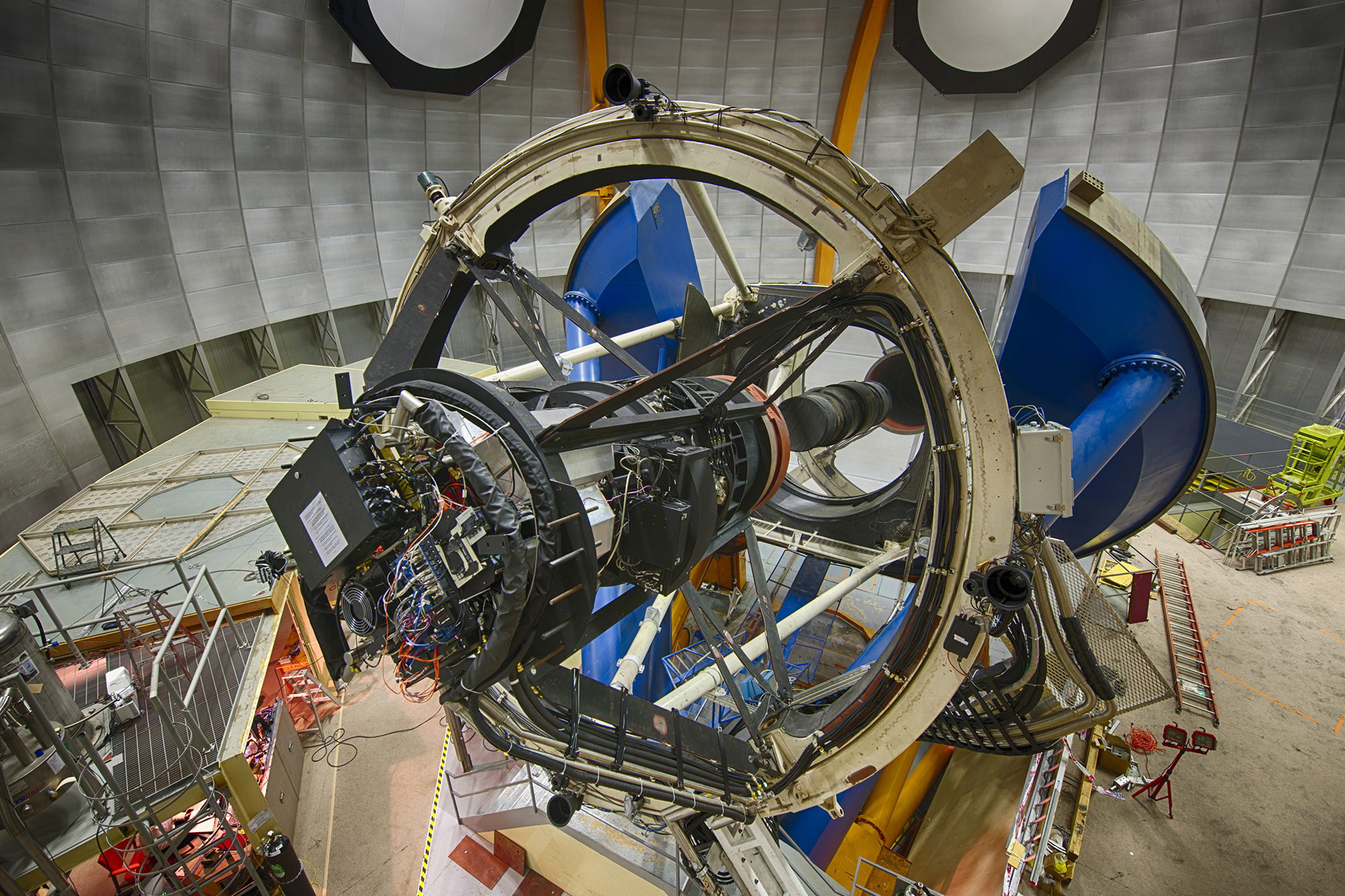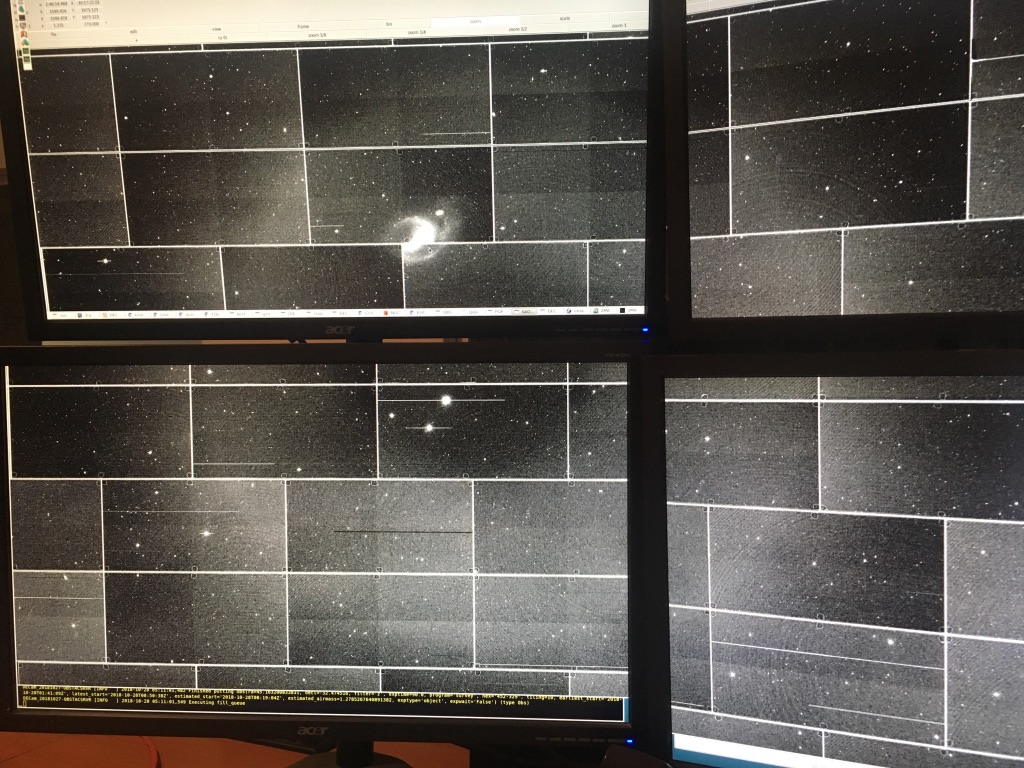Astronomers and cosmologists at Penn who are part of a global endeavor to catalog hundreds of millions of distant galaxies as part of the Dark Energy Survey (DES) are marking the end of six years of observations with the last image collection on Jan. 9.
DES represents one of the most promising ongoing studies of dark energy. “It’s a project that’s working to answer one of the biggest mysteries in our universe,” says Bhuvnesh Jain, a professor in Penn’s Department of Physics & Astronomy. “These data help us connect questions of fundamental physics with astronomy and cosmology.”
Jain, along with Masao Sako, Gary Bernstein, and research scientist Mike Jarvis, will continue to lead nearly 20 students, postdoctoral researchers, and staff members from the Department in studying these images for several more years. Sako co-led the DES effort to measure the expansion of the universe using distant stellar explosions and was also the co-coordinator of the Supernova group of DES in collaboration with Larry Gladney. Jain co-led the effort to map dark matter and infer the properties of dark energy using gravitational lensing. Bernstein, the project scientist for DES, played a crucial role in the calibration of the DES camera and was involved in planning the observation sequences. Jarvis has also served as a key member of the Penn DES team.
DES began mapping a 5,000-square-degree area, or approximately one-eighth of the entire sky, on Aug. 31, 2013. DES researchers are focused on understanding the nature of dark energy, the mysterious force that is believed to be causing the acceleration and subsequent expansion of the universe.
“We still only have clues about dark matter,” says Jain. “All of the known matter makes up less than 5 percent of the energy budget of the universe. About 25 percent is dark matter, and the remaining 70 percent is dark energy. So the vast majority of the universe is still completely unknown to us.”
Using the Dark Energy Camera, a 520-megapixel digital camera funded by the U.S. Department of Energy Office of Science and mounted on the Blanco 4-meter telescope at the National Science Foundation’s Cerro Tololo Inter-American Observatory in Chile, DES researchers collected data on 758 nights for more than six years. Over those nights, they recorded data from upwards of 300 million distant galaxies.
Among the 400 DES collaborators hailing from more than 25 institutions, Penn scientists made key contributions on the software that processes the vast quantity of sky images taken by the Dark Energy Camera. These images have since been used to study a variety of cosmic objects, ranging from planets in the outskirts of the solar system to galaxies and supernovae halfway across the observable universe.
Bernstein served as the co-chair of the Scientific Verification group and was charged with optimizing the Dark Energy Camera during its first few months of operations. This required daily teleconferences with observers and engineers in Chile as well as other key DES builders around the world.

“The camera is an extremely well-made instrument, but we were trying to measure things much more carefully than in previous surveys. We had to address known issues and fix them more carefully than had been done before,” says Bernstein. “So not only is DES one of the largest surveys ever done, it’s also one of the most accurate depictions of a large area of the sky.”
Over the course of the survey, hundreds of scientists were called on to work the camera in nightly shifts supported by observatory staff. To organize that effort, DES adopted some of the principles of high-energy physics experiments, in which everyone working on the experiment is involved in its operation in some way.
Numerous Penn researchers, including post-docs, graduate students, and all of the involved Penn faculty, were directly involved in image collection. Jain recently worked at the observatory over four nights in October 2018. His workday would begin with a 4 p.m. afternoon meeting, followed by time to set up the telescope, eat dinner, and watch the sun set over the mountains. Then, he says, the team would “hunker down and set things up for the night’s observations, which consist of a night-long sequence of one- to two-minute-long exposures.”
After ensuring that the scope is operating correctly and the focus is right, overseeing the telescope involves watching images from eight different computer monitors while choosing which filters to collect data from and, on the side, looking for interesting galaxies in the stream of images. Each image contains thousands of galaxies, most of them resembling small white dots because they are so far away, near the edge of the observable universe.

“The days are calm and productive, and the nights are intensely active. It’s invigorating and surreal, with the desolate landscape of the desert and the quiet isolation of the site somehow bringing it all together,” says Jain.
The DES collaboration has already produced around 200 academic papers. It’s also been a large component of Penn’s astronomy research. “DES has been a huge fodder for raw material for projects here at Penn: from Ph.D. theses to undergraduate projects to post-doc papers. It’s been the biggest resource for astronomy research here at Penn over the past few years,” says Bernstein.
One of the highlights of DES’ accomplishments involving Penn researchers was the discovery of DES16C2nm, a superluminous supernova explosion that exploded 10.5 billion years ago. DES16C2nm is the largest superluminous supernova ever detected, and scientists are using this discovery to better understand how cosmic objects, such as black holes and neutron stars, are formed.
Penn researchers were also involved in developing the largest contiguous maps showing the concentration of dark matter in the cosmos. These maps were created using complex algorithms that incorporate gravitational lensing and combines impressive sky coverage with accurate depictions of dark matter that provide insights into the formation of galaxies.

“We can now use this massive amount of data to tell us how gravity assembled concentrations of dark matter from the early universe to the present day, which tells us about dark energy,” says Jain.
Zooming in on galaxy clusters, Penn researchers found evidence for the boundary of dark matter ‘halos’: a subtle edge in the seemingly smooth distribution of dark matter. Both DES and Penn will continue to study this in the future and hope to find insights into the nature of dark matter through this work. “Penn has both the best data and the depth of expertise in this area of research,” says Jain.
Penn researchers also played a key role in the measurements of cosmic acceleration using Type 1a supernova discovered by DES and were also involved in the detection of a kilanova, a merger of two collapsed stars that became the densest form of observable matter in the universe. DES also led to the discovery of a new distant dwarf planet in the solar system.
Penn astronomers will now dive into the 50 terabytes of images to generate new results from DES, only a quarter of which have been analyzed so far. Results from their work will hopefully shed light on the nature of dark matter, and in the next few years, researchers will be able to see if their theories about dark matter match the data they collected.
“Now the main emphasis is to get all the science out of these images that we can,” says Bernstein. “The pictures are pretty, but they don’t give us an answer until we sweat a whole lot more.”

